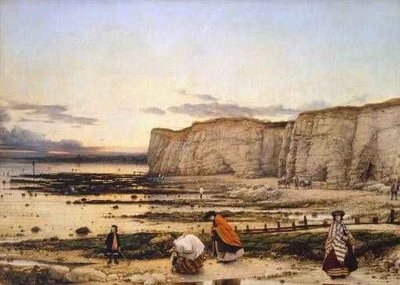25 May 2009
Pegwell Bay and the Theory of Evolution
One of the interesting things about writing the biography was in decoding information which the Victorians would have known but modern people probably don't.
I was looking at some information about Pegwell Bay in Kent, which features in Dyce's famous 1858 painting.

The people are collecting fossils, and the painting is often said to be a comment upon evolution. The idea that the world had NOT been created in 7 days, as stated in the Bible, was a great shock to many, but scientific evidence was marching on and the study of fossils was one of the ways in which people were coming to terms with the whole idea that the world had evolved.
What had escaped me is that Pegwell Bay was the site of the landing of St. Augustine in the 6th century, and he was generally thought to have brought Christianity to England.
So Dyce's picture was taking in both themes. The beginning and perhaps the beginning of the end of traditional Christian belief in the country.
Carroll probably saw the picture. I don't know what he made of it, nor what he might have made of the remains of the cross-channel Hoverport which is now also in Pegwell Bay.
I was looking at some information about Pegwell Bay in Kent, which features in Dyce's famous 1858 painting.

The people are collecting fossils, and the painting is often said to be a comment upon evolution. The idea that the world had NOT been created in 7 days, as stated in the Bible, was a great shock to many, but scientific evidence was marching on and the study of fossils was one of the ways in which people were coming to terms with the whole idea that the world had evolved.
What had escaped me is that Pegwell Bay was the site of the landing of St. Augustine in the 6th century, and he was generally thought to have brought Christianity to England.
So Dyce's picture was taking in both themes. The beginning and perhaps the beginning of the end of traditional Christian belief in the country.
Carroll probably saw the picture. I don't know what he made of it, nor what he might have made of the remains of the cross-channel Hoverport which is now also in Pegwell Bay.
 Feed
Feed
Natural science took a big step around this time... specially in evolutionary theory with Darwin. Most of the scientific basis to our modern evolutionary theory came up from the Victorian age.